When the Porsche Panamera 2nd Generation (Typ 971) was introduced in 2017, it was building upon the foundation set by the last generation Panamera. With its sleek new design, updated technology, and a lineup of powerful engines, the new Panamera Typ 971 was no slouch.
At the heart of the Panamera 2nd Generation lineup was a range of advanced engine options that catered to both performance enthusiasts and those seeking efficiency. The Panamera 4S featured a 2.9-liter twin-turbocharged V6 producing 440 hp, offering an exhilarating driving experience with a 0-60 mph time of around 4.0 seconds.

Photo by Motor Trend
For those craving even more power, the Panamera Turbo packed a 4.0-liter twin-turbocharged V8, delivering a potent 550 hp. In addition, Porsche introduced a groundbreaking hybrid model, the Panamera Turbo S E-Hybrid, which combined the V8 engine with an electric motor for a total of 680 hp.
Externally, the Panamera’s design evolved significantly with the Typ 971 generation. The car’s roofline was lowered, giving it a more coupe-like silhouette while maintaining its four-door practicality. The front fascia featured Porsche’s signature quad-LED headlights and a more sculpted, aerodynamic shape.
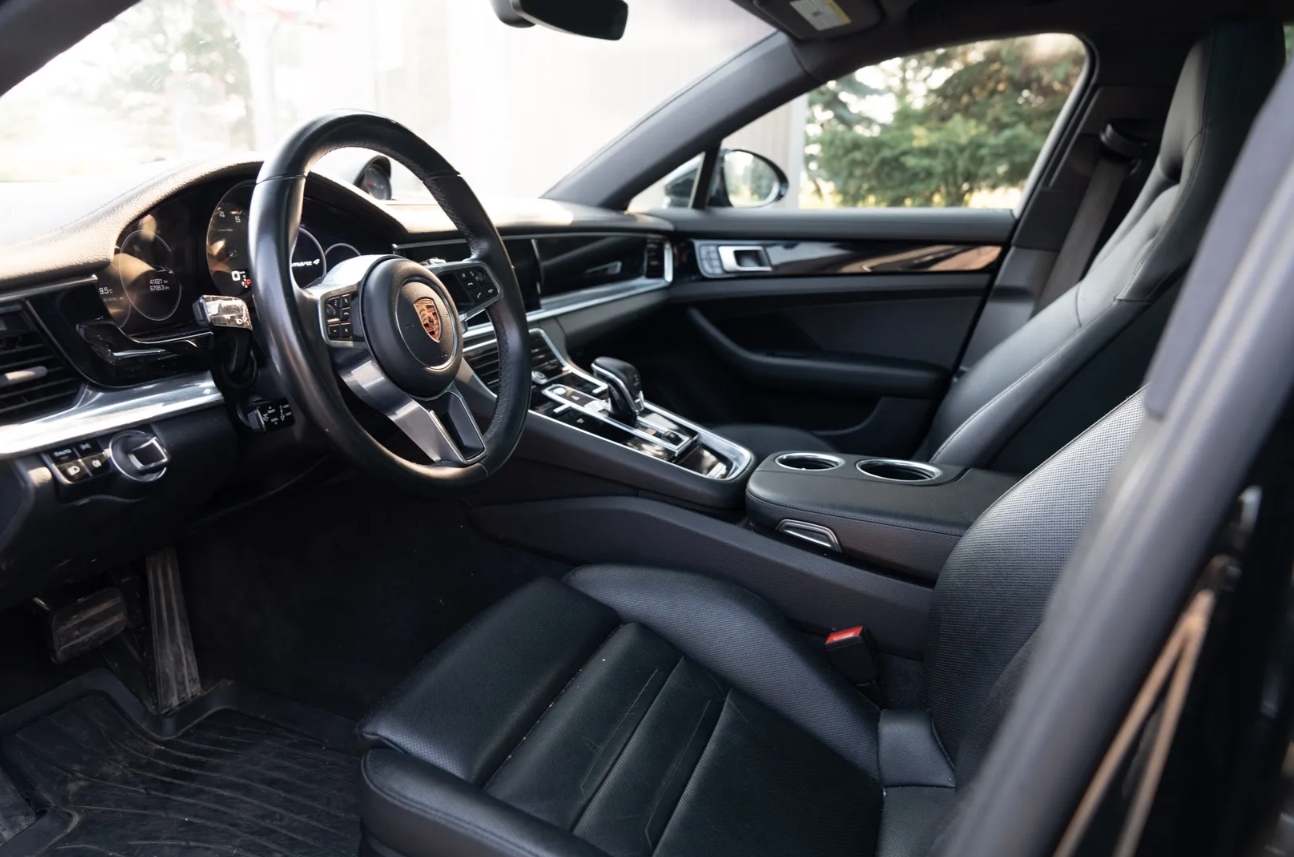
Photo by Bring a Trailer
From the side, the car’s elongated body and flowing lines enhanced its sporty yet elegant profile, while the rear end was modernized with a full-width LED light strip that seamlessly integrated into the taillights.
Inside, the Panamera offered a luxurious cabin. The traditional buttons were replaced with touch-sensitive panels, creating a clean, minimalist layout that centered around Porsche’s advanced Porsche Communication Management (PCM) system, featuring a large 12.3-inch touchscreen.

Photo by Cars and Bid
The driver enjoyed a digital instrument cluster that combined analog charm with modern technology, while high-quality materials such as leather, carbon fiber, and aluminum were used throughout the cabin to ensure a premium feel. Comfort was also a priority, with ample space for passengers and the availability of long-wheelbase Executive models that offered additional legroom for rear-seat occupants.
Throughout its production, the Panamera competed in the luxury performance sedan segment against formidable rivals such as the Mercedes-AMG GT 4-Door, BMW M8 Gran Coupe, and the Audi RS7. Despite the competition, the Panamera set itself apart with its blend of Porsche’s motorsport heritage, hybrid technology, and a balance of luxury and dynamic driving capabilities that few could match.
Model Changes (Breakdown by Year)
2017 Porsche Panamera
The 2017 Porsche Panamera introduced the second generation with a fresh design that addressed the first generation’s divisive styling. It featured a sleeker, coupe-like roofline, slimmer headlights, and an overall more aggressive look. Built on the new MSB platform, shared with the Bentley Continental GT, the Panamera gained improved rigidity and weight distribution.
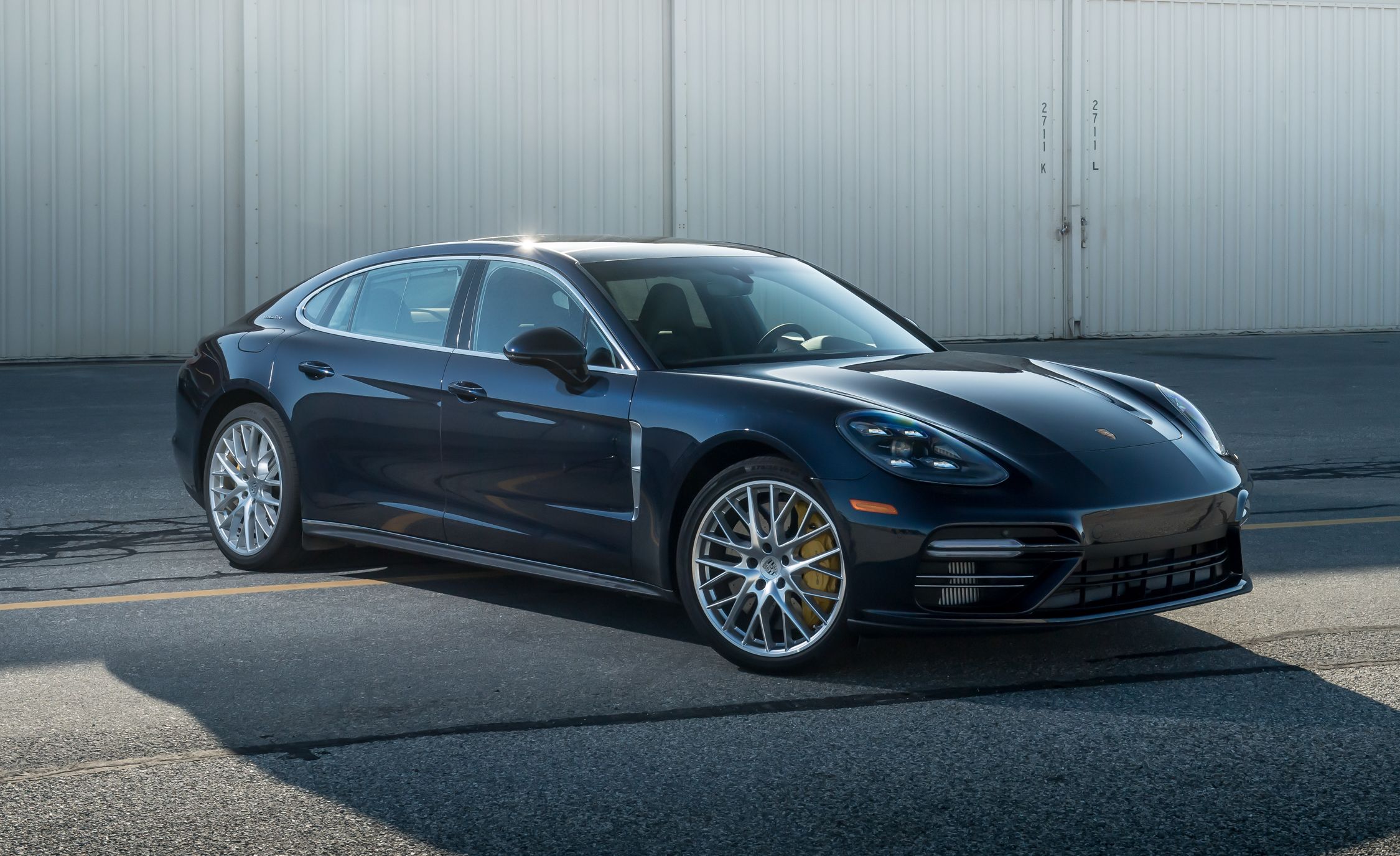
Photo by Car and Driver
Engine options included the Panamera 4S with a 2.9-liter twin-turbo V6 and the Panamera Turbo with a 4.0-liter twin-turbo V8. A hybrid variant, the Panamera 4 E-Hybrid, combined a V6 with an electric motor for added efficiency. Inside, the Panamera featured a fully digital cockpit with a 12.3-inch touchscreen and an 8-speed PDK transmission across all models.
The starting prices for the 2017 Porsche Panamera lineup were as follows:
- Porsche Panamera: Starting around $85,000
- Porsche Panamera 4S: Starting around $99,000
- Porsche Panamera 4 E-Hybrid: Starting around $100,000
- Porsche Panamera Turbo: Starting around $147,000
- Porsche Panamera Turbo Executive: Starting around $160,000
- Porsche Panamera 4S Executive: Starting around $106,000
- Porsche Panamera 4 Executive: Starting around $96,000
2018 Porsche Panamera
In 2018, Porsche expanded the Panamera lineup with new variants that added even more performance and versatility. The standout was the Panamera Turbo S E-Hybrid, which combined a 4.0-liter V8 engine with an electric motor to produce an astounding 680 horsepower. This made it the fastest Panamera at the time, offering incredible speed while maintaining the efficiency of a hybrid system.
Porsche also introduced the Panamera Sport Turismo, a new shooting brake body style that provided more practicality with increased rear-seat headroom and cargo space. Despite its wagon-like design, the Sport Turismo retained the sporty driving characteristics.
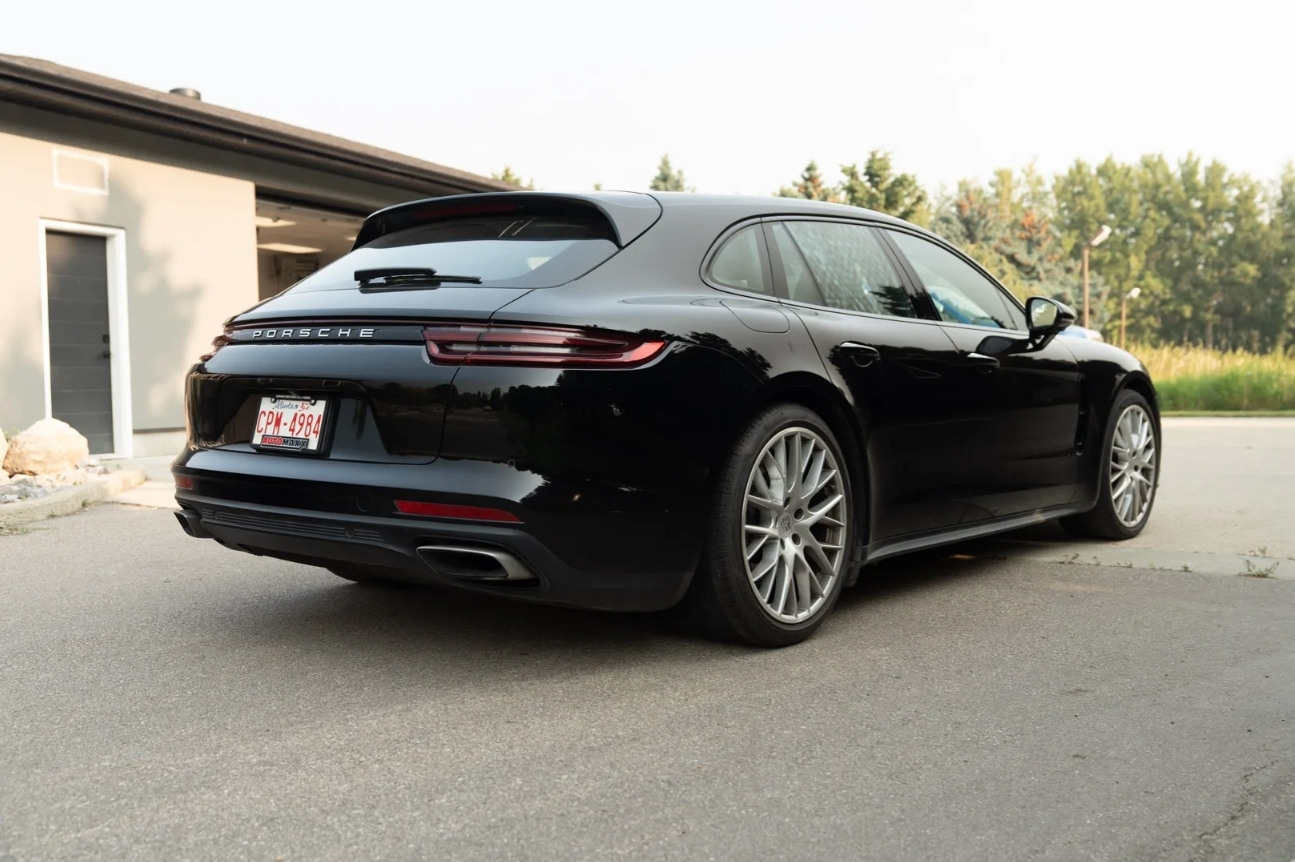
Photo by Bring a Trailer
Additionally, the Panamera GTS made its debut, featuring a detuned version of the 4.0-liter twin-turbo V8 engine, producing 460 horsepower. The GTS variant also boasted sportier suspension tuning and aggressive styling cues, it was more focused on driving enthusiasts.
The starting prices for the 2018 Porsche Panamera lineup were as follows:
- Porsche Panamera: Starting around $86,000
- Porsche Panamera 4: Starting around $90,000
- Porsche Panamera 4S: Starting around $104,000
- Porsche Panamera 4 E-Hybrid: Starting around $100,000
- Porsche Panamera GTS: Starting around $128,300
- Porsche Panamera Turbo: Starting around $151,500
- Porsche Panamera Turbo S E-Hybrid: Starting around $186,200
- Porsche Panamera Sport Turismo: Starting around $97,000
- Porsche Panamera Turbo Sport Turismo: Starting around $155,000
- Porsche Panamera Turbo S E-Hybrid Sport Turismo: Starting around $190,200
2019 Porsche Panamera
In 2019, Porsche introduced minor updates to the Panamera lineup. One of the notable changes was the addition of the Panamera Turbo S E-Hybrid Sport Turismo, which brought the hybrid powertrain to the wagon-style Sport Turismo model.
Alongside this new variant, Porsche continued to refine the Panamera’s technology. Improvements were made to the driver assistance systems, increasing safety and convenience, while connectivity options were expanded as well.

The Car Guide
The starting prices for the 2019 Porsche Panamera lineup were as follows:
- Porsche Panamera: Starting around $87,300
- Porsche Panamera 4: Starting around $91,950
- Porsche Panamera 4S: Starting around $104,600
- Porsche Panamera 4 E-Hybrid: Starting around $103,800
- Porsche Panamera GTS: Starting around $128,300
- Porsche Panamera Turbo: Starting around $151,500
- Porsche Panamera Turbo S E-Hybrid: Starting around $187,700
- Porsche Panamera Sport Turismo: Starting around $98,000
- Porsche Panamera 4S Sport Turismo: Starting around $110,200
- Porsche Panamera Turbo Sport Turismo: Starting around $155,500
- Porsche Panamera Turbo S E-Hybrid Sport Turismo: Starting around $190,200
2020 Porsche Panamera
In 2020, Porsche gave the Panamera a facelift and introduced several new models to the lineup. The exterior saw subtle tweaks, including a revised front bumper, new headlight and taillight designs, and updated wheel options. Inside, Porsche refined the digital cockpit further, improving connectivity and updating the infotainment system.
Engine upgrades were a highlight of this refresh. The Panamera GTS received a boost in power, with its 4.0-liter V8 now producing 473 hp. The Panamera Turbo S replaced the previous Turbo model and came equipped with a 620-horsepower version of the 4.0-liter twin-turbo V8, making it the fastest non-hybrid Panamera in the range.

Photo by Motor Trend
Also, Porsche introduced the Panamera 4S E-Hybrid, a new variant positioned between the standard hybrid and the Turbo S E-Hybrid, offering 552 hp.
The starting prices for the 2020 Porsche Panamera lineup were as follows:
- Porsche Panamera: Starting around $87,200
- Porsche Panamera 4: Starting around $91,800
- Porsche Panamera 4S: Starting around $105,000
- Porsche Panamera 4 E-Hybrid: Starting around $103,800
- Porsche Panamera GTS: Starting around $129,300
- Porsche Panamera Turbo S: Starting around $177,700
- Porsche Panamera Turbo S E-Hybrid: Starting around $187,700
- Porsche Panamera Sport Turismo: Starting around $98,000
- Porsche Panamera 4S Sport Turismo: Starting around $110,200
- Porsche Panamera Turbo S E-Hybrid Sport Turismo: Starting around $191,700
2021 Porsche Panamera
In 2021, the Porsche Panamera received a series of updates aimed at refining both its performance and design. The most noticeable changes came in the form of exterior tweaks, with a redesigned front and rear bumper, new headlight and taillight designs, and a full-width LED light bar at the rear, which gave the car a more modern and aggressive look.
Porsche also offered new wheel designs, enhancing the car’s sporty appearance.

Photo by Bring a Trailer
Performance saw significant upgrades with the introduction of the Panamera Turbo S, which replaced the previous Turbo model. With 620 horsepower, it became the fastest non-hybrid Panamera, offering a marked improvement over its predecessor’s 550 hp.
The Panamera GTS also received a power bump, now delivering 473 hp, making it even more performance-focused, while its suspension was recalibrated to deliver a sportier driving experience. The hybrid models, particularly the Panamera 4S E-Hybrid, also benefited from improved electric range and battery management, enhancing both power and efficiency.
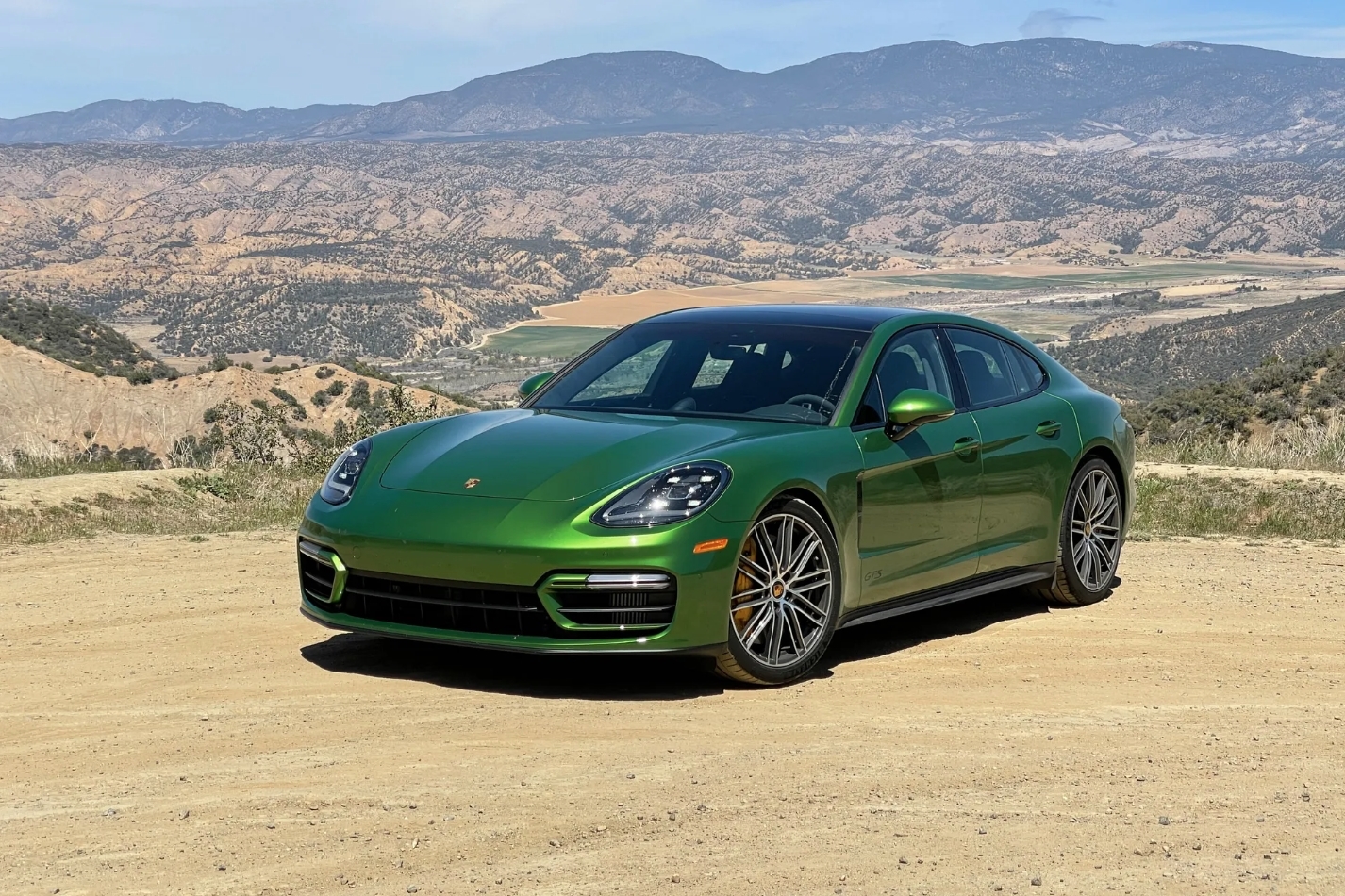
Photo by CNET
Inside, Porsche made several technology upgrades. The 2021 Panamera featured an updated Porsche Communication Management (PCM) system, which offered improved responsiveness, better connectivity, and seamless integration with services like Apple CarPlay.
Additionally, the driver assistance systems were enhanced, offering more advanced features such as improved adaptive cruise control, lane-keeping assist, and night vision assist.
The starting prices for the 2021 Porsche Panamera lineup were as follows:
- Porsche Panamera: Starting around $88,550
- Porsche Panamera 4: Starting around $93,350
- Porsche Panamera 4S: Starting around $106,350
- Porsche Panamera 4 E-Hybrid: Starting around $105,150
- Porsche Panamera GTS: Starting around $130,650
- Porsche Panamera Turbo S: Starting around $179,050
- Porsche Panamera Turbo S E-Hybrid: Starting around $191,150
- Porsche Panamera 4S E-Hybrid: Starting around $114,650
- Porsche Panamera Sport Turismo: Starting around $99,350
- Porsche Panamera 4S Sport Turismo: Starting around $113,350
- Porsche Panamera Turbo S E-Hybrid Sport Turismo: Starting around $193,050
2022 Porsche Panamera
For 2022, Porsche introduced a new Platinum Edition package, available on the Panamera, Panamera 4S, and Panamera 4 E-Hybrid models. This appearance package features black exterior trim, distinctive 21-inch wheels with a satin platinum finish, and smoked headlamp lenses for a more striking look. Inside, models equipped with this package boast Platinum Edition badging on the aluminum door sill protectors.

Photo by Cars and Bid
The 2022 Panamera also benefits from Porsche’s updated infotainment system, PCM 6.0, which now includes standard Android Auto integration, along with wireless Apple CarPlay connectivity and built-in access to Apple Music and Apple Podcasts.
The starting prices for the 2022 Porsche Panamera lineup were as follows:
- Porsche Panamera: Starting around $92,400
- Porsche Panamera 4: Starting around $97,000
- Porsche Panamera 4S: Starting around $106,400
- Porsche Panamera 4 E-Hybrid: Starting around $108,300
- Porsche Panamera GTS: Starting around $136,000
- Porsche Panamera Turbo S: Starting around $182,700
- Porsche Panamera Turbo S E-Hybrid: Starting around $193,800
- Porsche Panamera 4S E-Hybrid: Starting around $116,600
- Porsche Panamera Sport Turismo: Starting around $100,200
- Porsche Panamera 4S Sport Turismo: Starting around $115,300
- Porsche Panamera Turbo S E-Hybrid Sport Turismo: Starting around $197,600
2023 Porsche Panamera
Porsche hasn’t introduced any major updates to the Panamera for 2023. Although the model has remained mostly the same since its 2021 refresh, the most notable change for this year is the addition of standard adaptive cruise control across all trim levels.
Following 2023, Porsche introduced the third generation of the Panamera for 2024 wrapping up the 2nd generation of the Panamera.

Photo by Bring a Trailer
The starting prices for the 2023 Porsche Panamera lineup were as follows:
- Porsche Panamera: Starting around $93,850
- Porsche Panamera 4: Starting around $98,300
- Porsche Panamera 4S: Starting around $108,400
- Porsche Panamera 4 E-Hybrid: Starting around $110,200
- Porsche Panamera GTS: Starting around $137,350
- Porsche Panamera Turbo S: Starting around $184,200
- Porsche Panamera Turbo S E-Hybrid: Starting around $197,850
- Porsche Panamera 4S E-Hybrid: Starting around $118,200
- Porsche Panamera Sport Turismo: Starting around $101,900
- Porsche Panamera 4S Sport Turismo: Starting around $117,100
- Porsche Panamera Turbo S E-Hybrid Sport Turismo: Starting around $199,200
Porsche Panamera 2nd Generation (Typ 971) Common Problems
The Porsche Panamera 2nd generation is known for its Porsche heritage and reliability. However, like many vehicles, it is not without its issues. Some owners have reported recurring problems that can impact both reliability and overall driving experience. These problems, while not universal, are essential for potential buyers to consider and are best mitigated through regular maintenance and prompt attention to warning signs.
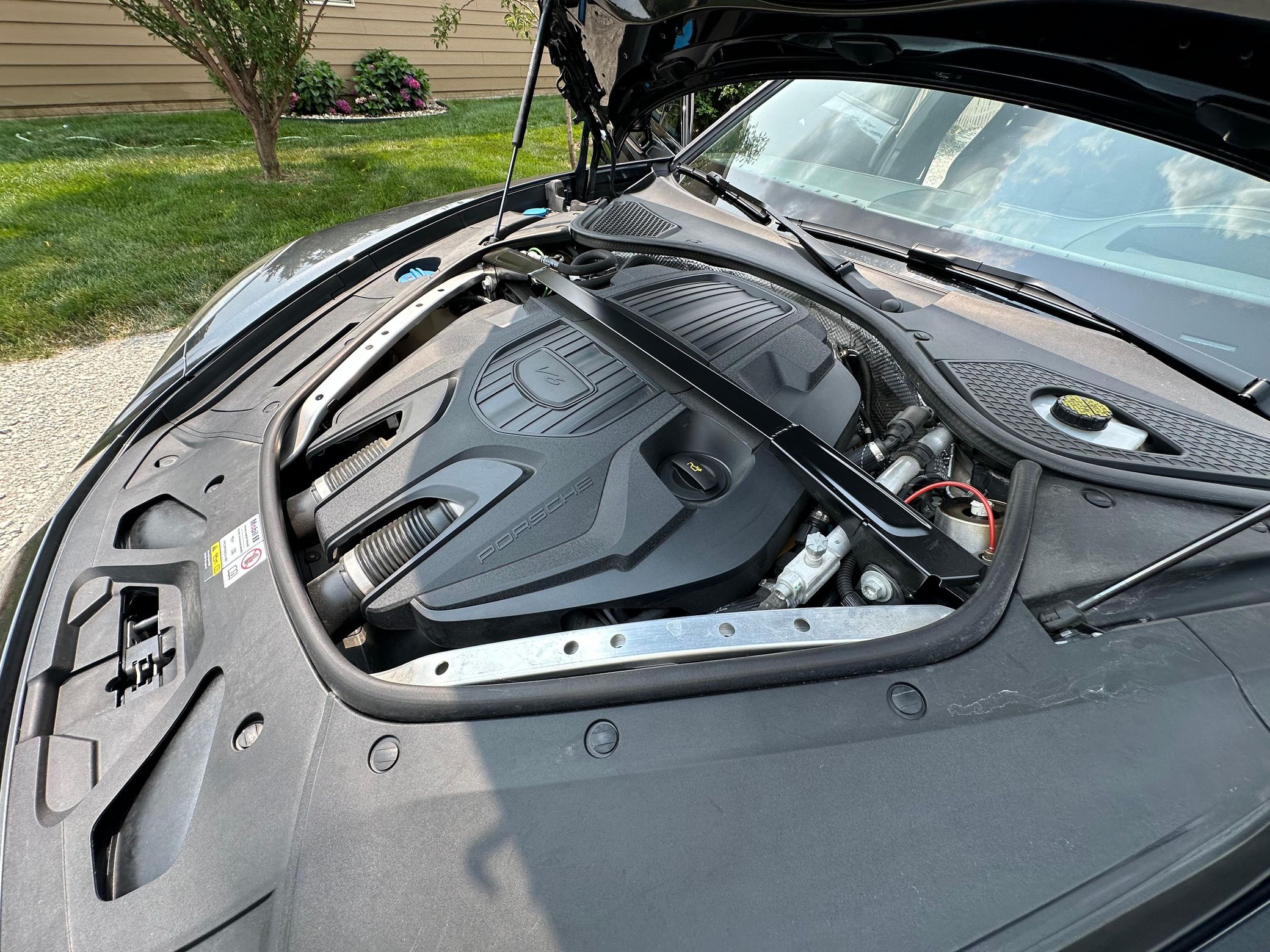
Photo by Cars and Bid
Keep in mind, that it is essential that all cars, can have issues and it is crucial to perform a Pre-Purchase Inspection (PPI) from an authorized dealer or experienced independent mechanic to reveal all issues.
Coolant Leaks: Many Panamera owners have reported coolant leaks, especially from the coolant expansion tank and water pump. These leaks can lead to overheating if not addressed promptly, risking significant engine damage if the coolant level drops too low.
Transmission Issues: Some drivers have experienced delayed gear engagement or rough shifting in the PDK transmission. These issues can range from minor annoyances to more significant problems, requiring inspection by a Porsche technician to avoid long-term transmission damage.
Air Suspension Failures: Panamera models equipped with air suspension systems can face issues such as air leaks or faulty air springs, leading to uneven ride height or a rougher ride. Proper maintenance is crucial to avoid costly repairs.
Electrical Glitches: Occasional electrical and software glitches have been reported, including issues with the infotainment system, screen freezing, and random audio system malfunctions. These can often be resolved with software updates or system resets.
Oil Pressure Monitoring Faults: Some Panamera owners have encountered oil pressure warning messages, especially at highway speeds. While it might be an electrical issue related to the oil pressure sensor, it’s essential to investigate to prevent potential engine damage.
Overheating at Idle: The auxiliary coolant pump in some Panameras has been known to fail, especially when the car is idling or stuck in traffic. This can cause the engine to overheat, leading to potential long-term engine problems if not fixed.
Recalls
2017 Panamera Turbo, 2018 and 2020 Panamera 4, 2018 Panamera 4 E-Hybrid, and 2019 Panamera 4 Sport Turismo vehicles
Seat belts: Rear/other: Anchorage (Recall no. 23V443000)
The screw that attaches the lower seat belt anchor to the seat frame on the outboard rear seats may not have been tightened properly. An improperly tightened seat belt anchor can detach during a crash, increasing the risk of injury.
2017 to 2021 Panamera, Panamera 4, Panamera GTS and Panamera Turbo vehicles
Electrical system (Recall no. 23V033000)
Humidity may enter the external coolant pump for the climate control system and cause an electrical short circuit. An electrical short circuit increases the risk of a vehicle fire.
2017 to 2020 Porsche Panamera vehicles
Exterior lighting: Headlights (Recall no. 22V656000)
The caps that cover the low-beam headlight horizontal adjustment screws are missing, which can allow the headlights to be improperly adjusted. As such, these vehicles fail to comply with the requirements of Federal Motor Vehicle Safety Standard number 108, “Lamps, Reflective Devices, and Associated Equipment.” Improperly adjusted headlights may not illuminate the road properly, or cause a glare to oncoming drivers, which can increase the risk of a crash.
2021 Panamera, Panamera 4 E-Hybrid, Panamera 4S, Panamera GTS, Panamera Turbo S vehicles
Seat belts (Recall no. 21V608000)
The seat belt automatic locking retractors may deactivate early, which can prevent the child restraint system from securing properly. As such, these vehicles fail to comply with the requirements of Federal Motor Vehicle Safety Standard number 208, “Occupant Crash Protection.” An unsecured child restraint system can increase the risk of injury during a crash.
2021 Panamera, Panamera Turbo S, Panamera GTS, Panamera 4, Panamera 4 Sport Turismo, Panamera 4 Executive, Panamera 4S Executive, Panamera 4S, Panamera 4S E-Hybrid, and Panamera 4 E-Hybrid vehicles
Suspension: Front (Recall no. 21V362000)
The front lower trailing arms were not forged correctly and may break. A broken front lower trailing arm may cause a loss of vehicle control, increasing the risk of a crash.
2017 Panamera 4, Panamera Turbo, Panamera Turbo Executive, 2017-2018 Panamera, Panamera 4S Executive, Panamera 4S, 2018 Panamera Turbo S Hybrid, Panamera 4 Hybrid Sport Turismo, Panamera 4 Sport Turismo, Panamera Turbo S Hybrid Sport Turismo, Panamera 4 Hybrid, Panamera 4 Executive vehicles
Service brakes (Recall no. 19V735000)
The instrument cluster may not provide a visual warning when the brake pads are worn out. As a result, these vehicles fail to comply with Federal Motor Vehicle Safety Standard (FMVSS) number 135, “Light vehicle brake systems.” If the driver is not alerted when brake pads are worn out, the vehicle may not respond as expected when braking, increasing the risk of a crash.
2017 Panamera vehicles
Air bags: air bag/restraint control module (Recall no. 19V533000)
The air bag Electronic Control Unit (ECU) may have a defective power supply capacitor that can result in air bag deactivation or inadvertent deployment of the air bags. Deactivated air bags increase the risk of injury. Inadvertent deployment of the air bags increase the risk of a crash.
2018 Panamera, Panamera 4, Panamera 4 E-Hybrid, Panamera 4 E-Hybrid Executive, Panamera 4 E- Hybrid Sport Turismo, Panamera 4S, Panamera Turbo, Panamera Turbo Executive, Panamera 4 Sport Turismo, Panamera Turbo S E-Hybrid Sport Turismo vehicles
Electrical system (Recall no. 19V180000)
Incorrect soldering of a control unit may result in the intermittent failure of various systems, possibly affecting vehicle driveability. Impaired vehicle driveability can increase the risk of a crash.
2018 Panamera 4 Executive, Panamera 4S Sport Turismo, Panamera 4 Hybrid, Panamera 4 Hybrid Executive, Panamera 4 Hybrid Sport Turismo, Panamera Turbo Sport Turismo, Panamera Turbo S Hybrid Executive, Panamera Turbo S Hybrid, Panamera 4 Sport Turismo and Panamera Turbo S Hybrid Sport Turismo vehicles
Service brakes (Recall no. 19V115000)
The instrument cluster may not provide a visual warning when the brake pads are worn out. As a result, these vehicles fail to comply with Federal Motor Vehicle Safety Standard (FMVSS) number 135, “Light vehicle brake systems.” If the driver is not alerted when brake pads are worn out, the driver may lose control of the vehicle while attempting to brake, increasing the risk of a crash.
2017 to 2018 Porsche Panamera, Panamera 4, Panamera 4S, Panamera Turbo, Panamera 4S Executive, Panamera Turbo Executive, 2018 Panamera 4 Executive, Panamera 4 E-Hybrid, Panamera Turbo S E-Hybrid, Panamera 4 E-Hybrid Executive, Panamera S E-Hybrid Executive, Panamera 4 Sport Turismo, Panamera 4S Sport Turismo, Panamera 4 E-Hybrid Sport Turismo, Panamera Turbo Sport Turismo, and Panamera Turbo S Sport Turismo vehicles
Steering: Electric power assist system (Recall no. 18V898000)
A software failure may result in an intermittent loss of electric power steering assist. An intermittent loss of power steering assist can increase the risk of a crash.
2018 Porsche Panamera Turbo S Hybrid Executive, Panamera 4 Hybrid, Panamera Turbo S Hybrid, Panamera 4 Hybrid Executive, Panamera 4 Hybrid Sport Turismo, and Panamera Turbo S Hybrid Sport Turismo vehicles
Service brakes, hydraulic (Recall no. 18V841000)
The brake lines installed on the front axle may corrode over time. Corrosion inside the line may affect the front braking performance. Braking ability that is reduced due to a corroded brake line can increase the risk of a crash.
2017 to 2018 Panamera 4S, Panamera Turbo and Panamera Turbo Executive and 2018 Panamera Turbo S E-Hybrid, Panamera Turbo S E-Hybrid Executive, Panamera 4S Sport Turismo, Panamera Turbo Sport Turismo, Panamera Turbo S E-Hybrid Sport Turismo, and Panamera 4S Executive vehicles
Suspension: Rear (Recall no. 18V388000)
The connecting links may detach from the rear-axle anti-roll bar potentially damaging the surrounding suspension parts and affecting the vehicle’s handling. An unexpected change to the vehicle’s handling can increase the risk of a crash.
Maintenance and Ownership Costs
Owning a Porsche Panamera 2nd generation comes with a higher level of maintenance and ownership costs compared to standard luxury vehicles, but it’s relatively in line with other high-performance cars. Routine maintenance, such as oil changes, brake servicing, and tire replacements, can be more expensive due to the use of premium parts and specialized labor.
While taking your Panamera to a Porsche dealer for servicing typically results in higher expenses, opting for an independent Porsche specialist can often reduce repair costs while maintaining the same quality of service.
Here are the suggested service schedule and intervals per Porsche:
OIL CHANGE SERVICE:
- Oil & Filter Change: Every 10,000 miles (15,000 km) or 1 year (whichever comes first)
- Uses approximately 9 quarts of oil for the V8 engine.
INTERMEDIATE MAINTENANCE (Every 20,000 miles or 30,000 km):
- Change engine oil & filter
- Check operation of wiper/washer system and headlight cleaning system
- Check tire pressure and tire condition
- Inspect brake lines, brake pads, and discs for wear
- Read diagnostic fault codes and reset maintenance interval
- Inspect battery, coolant levels, wiper blades, and headlight adjustment
REGULAR MAINTENANCE (Every 40,000 miles or 60,000 km):
- Change engine oil & filter
- Inspect brake hoses, brake system, and fluid levels
- Check steering, tie rods, and suspension components for wear
- Perform visual inspection of exhaust system for leaks and damage
- Check radiator and air intakes for contamination
- Replace air filter (if applicable)
- Test all lights and replace as needed
ADDITIONAL MAINTENANCE (Every 2 Years):
- Change brake fluid
- Check tire sealing compound for expiration
- File condition report for long-life guarantee
SPARK PLUG REPLACEMENT:
- V6 and GTS Models: Every 40,000 miles (60,000 km) or 4 years
- V8 S and Turbo Models: Every 30,000 miles (45,000 km) or 4 years
- V8 S E-Hybrid: Every 40,000 miles (60,000 km) or 4 years
ADDITIONAL MAINTENANCE (Every 80,000 miles or 120,000 km):
- Replace air cleaner filter element
Change oil in all-wheel and rear final drives (for applicable models)
Here is a rough estimate of typical service costs associated with the Porsche Panamera:
- Oil Change – The cost of an oil change for the Panamera ranges from $300 to $500, depending on the model and service location. Porsche typically recommends synthetic oil, which adds to the cost but extends the intervals between changes to about 10,000 miles.
- Minor Service – A minor service, typically performed every 20,000 miles, includes an oil change, filter replacement, and a general inspection. The cost for this service is usually around $500 to $800.
- Major Service – A major service, which occurs every 40,000 miles, is more comprehensive and includes items such as spark plug replacement, brake fluid change, and transmission servicing. The cost for a major service can range from $1,200 to $2,000, depending on additional repairs and labor involved.
- Tires – Replacing all four tires on a Panamera, particularly performance tires, can cost between $1,200 and $2,500, depending on the brand and type of tires used.
- Brakes – For brakes on the Porsche Panamera, the cost of replacement varies significantly based on whether the car is equipped with standard brakes or Porsche Carbon Ceramic Brakes (PCCB).
- Porsche Carbon Ceramic Brakes (PCCB): If your Panamera is equipped with Porsche’s high-performance carbon-ceramic brakes, the cost can be significantly higher. Replacing PCCB pads and rotors can range from $10,000 to $15,000 for a complete front and rear replacement. Carbon-ceramic brakes are much more expensive due to the specialized materials and manufacturing process but offer superior performance and longevity under high-stress driving conditions.
- Standard Brakes: For models equipped with standard steel brakes, replacing the brake pads and rotors for both the front and rear typically costs between $1,500 and $3,000. This range depends on whether you’re using OEM parts or aftermarket components, and the labor rates of the service provider.
- Transmission – The Porsche Panamera’s PDK dual-clutch transmission requires regular maintenance, with fluid changes recommended every 40,000 to 60,000 miles, costing around $800 to $1,500. While major issues are uncommon, repairs can range from $4,000 to $8,000, and full transmission replacements can reach up to $20,000, depending on the extent of the damage.
Options List
When purchasing a Porsche Panamera 2nd generation, there are several key options and packages that you can consider.
The options are divided into a few categories.

Photo by Cars and Bid
For those prioritizing performance, the Sport Chrono Package is a good choice. It adds launch control, dynamic engine mounts, and a driving mode switch on the steering wheel, improving the Panamera’s handling and acceleration.
This package is particularly beneficial for drivers looking to maximize the Panamera’s dynamic capabilities. Models like the Panamera GTS or Turbo S E-Hybrid can further benefit from this package, as it sharpens throttle response and enhances overall performance.

Photo by Cars and Bid
In terms of luxury, the Premium Package Plus is a popular option, offering features such as adaptive LED headlights, 14-way power seats with memory, ventilated seats, and soft-close doors. It elevates the interior comfort and adds a touch of refinement, making the Panamera a more enjoyable daily driver.
For those seeking a more immersive experience, the Burmester 3D High-End Surround Sound System is another highly regarded upgrade.

Photo by Cars and Bid
For technology and driver assistance, the InnoDrive with Adaptive Cruise Control is an advanced system that adjusts speed based on navigation data, making highway driving smoother and safer. The Night Vision Assist is another cutting-edge feature, using thermal imaging to detect pedestrians or animals in low-light conditions.
Personalization is also a strong selling point for the Panamera. Porsche offers a wide array of exterior colors, interior materials, and wheel designs, allowing buyers to personalize their car to reflect their tastes through the Porsche PTS program.

Photo by Porsche
The Porsche Paint to Sample (PTS) program is one of the most exclusive customization options offered by Porsche, allowing buyers to select from a vast palette of unique and rare colors that are not part of the standard color offerings.
This option is particularly popular with Porsche enthusiasts who want to make their car stand out from the crowd by choosing a color that reflects their personal style or pays homage to classic Porsche hues from past models.

Photo by Bring a Trailer
With PTS, buyers can choose from over 100 colors, including iconic shades like Rubystar, Voodoo Blue, and Signal Yellow, many of which have historical significance in the Porsche lineup. The Paint to Sample program ensures that each Panamera is distinct, with a color that is meticulously applied to achieve flawless results.
The PTS process is done at Porsche’s factory, using the same high standards as their regular paint options, ensuring durability and a premium finish. Vehicles with rare PTS colors often hold their value better and can command a premium in the resale market due to their uniqueness.

Photo by Rennlist
Additionally, the SportDesign Package adds more aggressive exterior styling cues, including a distinctive front fascia and rear diffuser, enhancing the Panamera’s visual appeal.
When considering market stability, models equipped with performance-oriented options and exclusive packages like Porsche Carbon Ceramic Brakes (PCCB) and all-wheel drive (available on select variants) tend to retain higher resale value. These options not only boost performance but also appeal to enthusiasts, ensuring that the car remains desirable in the long run.
It’s also important to consider the condition, mileage, and service history when purchasing a used Panamera, as well-maintained models with desirable options are likely to hold their value better over time.
2017 Porsche Panamera Options List



2021 Porsche Panamera Options List

Key Options
- Sport Chrono Package
- Porsche Carbon Ceramic Brakes (PCCB)
- Burmester 3D High-End Surround Sound System
- InnoDrive with Adaptive Cruise Control
- Rear-Axle Steering
- Paint to Sample (PTS)
Porsche Panamera 2nd Generation Price and Values
The Best Porsche Panamera 2nd Generation to Buy
When it comes to choosing the best Porsche Panamera 2nd generation, several key factors should be taken into consideration, including engine options, available features, and the vehicle’s overall condition.
For those seeking the best version of the 971 generation Panamera, the 2020 model year is a strong choice. By this year, Porsche had introduced various refinements, including updated technology, enhanced interior materials, and the availability of additional performance packages such as the Sport Chrono Package.

Photo by Bring a Trailer
The 2020 Panamera also benefits from a range of engine options, from the efficient V6 to the more powerful V8 and hybrid powertrains, giving buyers flexibility depending on their performance preferences.
In addition to selecting a model year, it’s essential to evaluate the condition and mileage of the Panamera. Well-maintained vehicles with low mileage are likely to retain more value over time, particularly if they come with a complete service history.

Careful research, comparing prices, and prioritizing well-kept cars will help maximize your investment, especially if you are considering long-term ownership or resale value.
Ultimately, the best Panamera for you will depend on your needs, preferences, and budget. A well-maintained 2020 Porsche Panamera with low mileage and a comprehensive service record is a smart choice for those seeking a usable family friendly Porsche with long-term value in mind.
Conclusion
In summary, with a starting price around $80,000+, the Porsche Panamera 2nd generation offers a lot of car for the money. As a four-door sedan, it stands out with its wide range of engine options, including powerful V8s and efficient hybrid variants, along with extensive customization choices like the Paint to Sample (PTS) program.
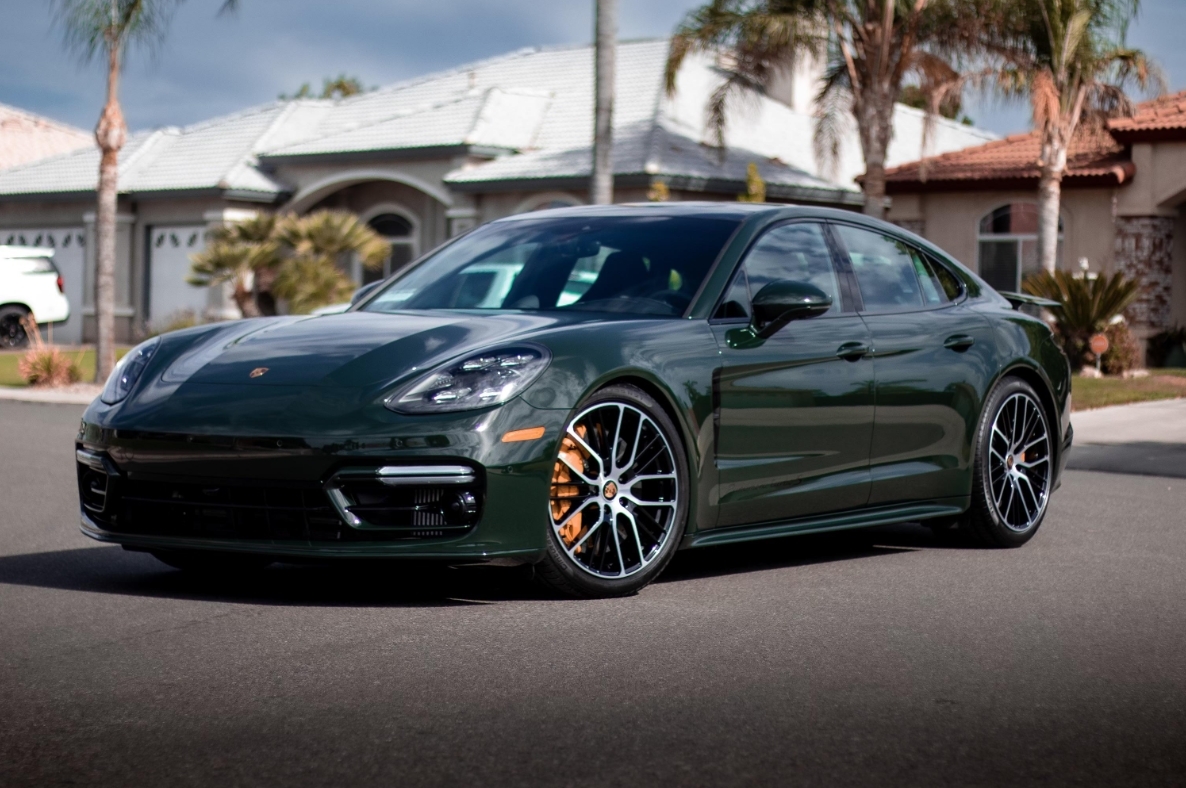
While competitors such as the Mercedes-AMG GT 4-Door, BMW M8 Gran Coupe, and Audi RS7 offer strong alternatives in the luxury performance sedan market, the Panamera stands out itself through its refined handling, premium interior, and the combination of Porsche’s racing heritage with grand touring comfort.
For those seeking a high-performance luxury sedan that offers both driving exhilaration and daily usability, the Porsche Panamera 2nd generation is an excellent choice.
Car Hacking Shortcuts
-
Look for models with the Sport Chrono Package for enhanced performance and driving dynamics.
-
Prioritize models with high-demand features such as the Porsche Carbon Ceramic Brakes (PCCB) or the Premium Package Plus to boost resale value.
-
Paint to Sample (PTS) colors for exclusivity and long-term value retention.
-
Seek out CPO (Certified Pre-Owned) vehicles to take advantage of warranty coverage and avoid steep depreciation.
-
Focus on well-maintained, low-mileage Panamera.
Resources
- 2017 Porsche Panamera Version 1 Brochure PDF
- 2017 Porsche Panamera Version 2 Brochure PDF
- 2017 Porsche Panamera Version 3 Brochure PDF
- 2018 Porsche Panamera Sport Turismo Brochure PDF
- 2021 Porsche Panamera Brochure PDF
The post Porsche Panamera 2nd Generation (Typ 971) Buyers Guide first appeared on Exotic Car Hacks.
The post Porsche Panamera 2nd Generation (Typ 971) Buyers Guide appeared first on Exotic Car Hacks.

